
|
"Just say No" to Rebuilt Auto Electrics
|
| I have long advocated buying new
replacement parts instead of "rebuilt" or "remanufactured" parts.
Reman parts used to be OK. Then the Wall Street types invaded the
industry and things went to hell in a handbasket. A couple of years ago I
got caught out on a trip with a bad alternator. I could not find a new
part so I opted for an AutoZone rebuilt special. I had barely gotten
home when this one quit. Before returning it, I decided to open it up
and take a look-see. Glad I did. This is a perfect example of
why one should NEVER, EVER buy a reman part. |

Remans rejected since 05/23/07
|
| Here is the view of the rectifier end bell.
If it looks sand blasted, that is because it has been. The standard
procedure now is to disassemble every alternator that comes in, dump the
parts in the sand blaster and blast away. Note that the condenser has
been blasted. Real good for long life. Grit was even found in
the bearing grease. |
 |
| Here is the reason the unit failed. This
is the positive output stud. There is supposed to be an insulating
washer under that stud. If there ever was one it is gone now.
Note the sand blast damage and the rust. |
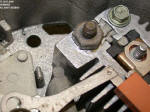 |
| A view of the brushes. Even though there
is less than 1000 miles on this alternator, the brushes are worn out.
Or more accurately, they are the brushes that the alternator had when it
arrived at the reman shop. |
 |
|
| Another view of the output stud. From the
scratches on the aluminum I would guess that there was an insulator there
but that it didn't get put back in after the "reman". |
 |
|
| The stud removed |
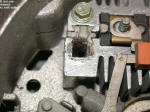 |
|
| The stud itself. Note the burnt plastic
under the red part. Also note the rust. |
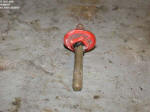 |
|
| |
Here we get a good view of the stator. The
"reman" process involves applying a high speed sanding drum to the stator
poles. This does a couple of things.
First it shorts the laminations together (green arrow), causing higher
eddy currents in the stator and more heating.
Second, when the operator slips, it removes the insulation from the
windings (red arrows). |
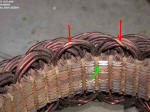 |
|
Here we see the slip rings. Looks like one
got in the way of a hammer! That lump works wonders for brush life! |
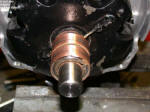 |
|
I'm not sure what all is going on here, as the
field has been subjected to the black paint treatment, AKA "overhaul in a
can". The winding looks and smells burnt but I'm not sure if that is
the paint or the actual winding. |
 |
|
A final overall view. Again one can see
the massive sandblast effects and the worn out brushes. It did look purty
from the outside, though, what with all that sand blasting and the silver
paint and all.
Do you want to rely on something like this on your next trip? |
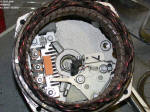 |











